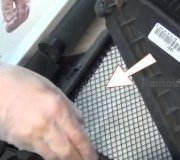I'm getting ready to try this on my wife's 1992 Buick Century. I can let you know how it goes, but I've read and thought about it enough to have a general idea. You do need a spring compressor. There are basically two types for a pushrod engine, which I assume yours is. One is like an angled prybar, which uses the rocker stud as a fulcrum. The other costs a bit more ($25) but is what I opted for, since it leaves both hands free to remove the spring. It's called an overhead compressor, and works by jaws and a screw. I guess it also would be the one to use if you have rocker shafts and therefore no stud next to the spring. You do also need either an air compressor with spark plug hole adapter for the hose OR a 10-foot length of 1/4-inch diameter nylon rope. You'll also need new valve cover gaskets.
Remove the negative battery terminal. Remove all the spark plugs and both valve covers. Stuff rags or paper towels into the oil return galleries in the heads to keep stuff from fallling in. With a large ratchet on the crankshaft pulley, turn the crank to TDC on whichever cylinder you're going to work on. If you're using air pressure to hold the valves shut, make sure the crank is stabilized at TDC; otherwise the air pressure will push the piston down and if for some reason you lose air pressure, the valve will drop inside the cylinder. If you're using the rope, turn the cylinder to the beginning of the compression stroke (after the intake valve closes) and stuff about 8 feet in through the spark plug hole. Be sure to leave some hanging out for retrieval! Turn the crank until you feel resistance.
Remove the rocker arms of the cylinder you're working on. Have needle-nosed pliers and your magnetic retriever handy as you compress the springs and remove the small split valve keepers from between the stem and the center of the spring retainer. You can also at this point put rubber bands around the stems to keep them from falling into the cylinder and temporarily turn off the air or, with the rope, back off the crank, to check the condition of the valve guides, the passages in the head that the valve stem goes through. Turn the stem, move it in and out and wiggle it to check for play. If play seems excessive (the tolerance should be very close) or valve binds, you'll need to remove the head for service. You can also at this point check the valve springs for proper height and obvious defects or damage.
Install the new seals, which may be different for intake and exhaust. Put a little oil on the seal to protect it from getting nicked on the keeper groove. Mine came with a protector that looks like a piece of soda straw. Some older valves use simple O-rings under the retainer and/or umbrella-shaped seals that aren't really seals as much as shields on the stem to deflect oil from running down it. Others, called positive stop seals, fit down onto the shoulder of the valve guide, , and are stationary.
That's it. I think you've got hydraulic lifters on this engine, so valve lash adjustment afterward shouldn't be necessary.
Wednesday, June 25th, 2008 AT 12:37 PM


